


The Antarctic Field Guides is a collaborative tool offering free access to information that can help you identify Antarctic organisms. Thanks to the initial efforts from Prof. Andrew Clarke, Dr David Barnes (British Antarctic Survey) and Dr Stefano Schiaparelli (University of Genoa and Italian National Antarctic Museum), it allows users to build a tailor-made, customized guide, to be taken in the field or simply browsed. The pages are generated on-the-fly from the contents of authoritative, quality controlled data resources (SCAR-MarBIN and ANTABIF, RAMS , GBIF), and ensures the user to access up-to-date information about the group of organisms he/she is interested in. Even if the primary focus is for scientists, the AFGs are open and free for all to enjoy.
The maps of the AFGs are generated using publicly available occurrence records accessible through data.biodiversity.aq and may not represent the full range.
The content of the AFGs is under the CCBY licence. You are welcome to share or remix the content of the AFGs. For the moment, we kindly ask you to cite the source as ‘The SCAR Antarctic Field Guides. World Wide Web publication, available online at http://afg.biodiversity.aq"
Some media content is under the Creative Commons Attribution - Noncommercial - Share Alike 3.0 License.
4
Scientific name
British Antarctic Survey
Reaches up to around 2cm long. Serolids are flattened and disc-shaped.
Often found in shallow water, between 3 and 20m. Paraserolis polita lives fully buried in soft sediments such as mud and sand, from Sub-Antarctica to the Antarctic Peninsula and Continent.
5
Paraserolis polita is a predator and feeds on a variety of small invertebrates, particularly amphipods and polychaete worms. It lives for up to 6 years and reaches maturity after about 2, breeding every two years. Eggs are laid in autumn and brooded in a marsupium for a year and a half, and then the young are released in spring. This long incubation period is probably timed to coincide the release of juveniles with the most productive part of the Antarctic season.
6
Scientific name

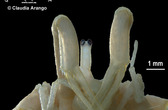

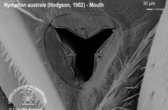
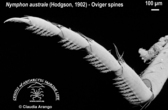
N. australe has a circumpolar distribution, but it is found also in more temperate zones as New Zealand, Falkland Islands, off the coast of Chile and Argentina, and Southern Indian Ocean (Child, 1995).
7
Nymphon australe is the most frequently collected of all pycnogonid species in Antarctic area (Munilla & Soler-Membrives, 2009) and in the highest numbers (Arango et al, 2010). It is considered circumpolar and eurybathic, found in most Antarctic and subantarctic benthic collections. As most of pycnogonids Nymphon australe lacks a planktonic stage (Arnaud & Bamber, 1987).
Thus, it is of interest to understand how these marine organisms with an apparent limited dispersal capacity have achieved such wide geographical and bathymetric distributions. N. australe is classified within a group of Southern Ocean species of Nymphon sharing few morphological characters such as inflated ovigers, a robust body and setae present on trunk and legs. This group of species or 'australe-complex', is to be tested in a phylogenetic context using both morphology and molecular data to understand the diversification of the group, their relationships to other Antarctic (~60 spp.) species and also the evolutionary history of the cosmopolitan Nymphon (~270 spp.) (Arango et al., 2010).
8
Scientific name
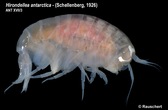
9
Scientific name
British Antarctic Survey
Yellow, growing up to around 1cm in size
0 to 800m from Sub-Antarctica and South Georgia to the Antarctic Peninsula and Continent.
10
Orchomenella pinguides mostly eats carrion and fecal matter, feeding in swarms. It is preyed on by octopus and by the emerald rockcod Trematomus bernacchii.
11
Scientific name
British Antarctic Survey
This species is very distinctive, being red and fairly squat, with a spiky outline. It is large for an amphipod and reaches up to 7cm in length
Found as shallow as intertidal depth, but more usually deeper, between 80 to 550m. It occurs from Sub-Antarctica to the Antarctic Peninsula and Continent
12
Epimeria rubrieques is an ambush predator with a variety of prey. It can swim, but only rarely does so.
13
Scientific name
British Antarctic Survey
Reaches up to 2.5cm in size
0 to 800m, but most common in deeper waters (below 50m). Found from Sub-Antarctica to the Antarctic Peninsula and Continent.
14
Abyssorchomene plebs is an omnivorous scavenger and predator, and feeds in swarms on carrion, fecal matter and sometimes on live animals in a mass assault. It is preyed on by fish and the Antarctic tern (Sterna vittata) which probably eats it when carcasses containing amphipods get washed ashore. Abyssorchomene plebs reaches maturity after 18 months and reproduces and develops eggs in winter so that the young hatch out in spring. Experiments on this species have shown that the optimum temperature for its lifestyle is below freezing and it cannot tolerate temperatures much above 8 oC. This is probably the case for most Antarctic animals.
15
Scientific name
British Antarctic Survey
Orange in colour
Found amongst algae in shallow water, along the Antarctic Peninsula and Continent.
16
This is a motile free-living species. Little is known of its ecology but it is opportunistic and has been reported feeding on decaying algae.
17
Scientific name

18
Scientific name
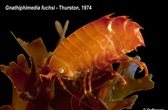
19
Scientific name
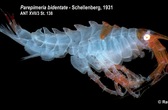
20
Scientific name
British Antarctic Survey
Large for an amphipod, reaching up to 4cm, and with an overall roundish shape.
80 to 550m, from Sub-Antarctica to the Antarctic Peninsula and Continent. It is found on the substrate or on benthic organisms such as sponges.
21
Epimeria robusta is an ambush predator and feeds on a variety of small invertebrates including plankton, sponges, worms, echinoderms and other crustaceans. In its turn it is preyed on by fish and squid
22
Scientific name
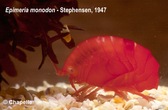
23
Scientific name

24
Scientific name

25
Scientific name
British Antarctic Survey
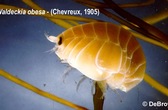
Yellow or brown in colour and roundish and squat in outline. Reaches up to 3.5cm long
Found down to 660m, but most abundantly in shallow algae, from Sub-Antarctica to the Antarctic Peninsula and Continent
26
Waldeckia obesa is a necrophage. It eats carrion, usually in a highly decomposed state. Although it lives in sub-tidal waters one of its predators is known to be the Antarctic tern (Sterna vittata). Possibly in this instance predation occurs when carcasses containing amphipods get washed ashore, bringing them within easy reach of the birds.
27
Scientific name

28
Scientific name
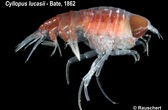
29
Scientific name

30
Scientific name
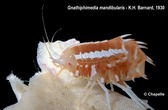
31
Scientific name
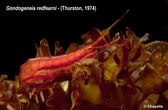
32
Scientific name
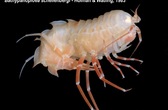
33
Scientific name
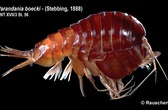
34
Scientific name
British Antarctic Survey
Reaches up to 1cm long
2 to 457m, from southern Argentina to Continental Antarctica. Heterophoxus videns lives buried in soft sediments. It often occurs in dense groups.
35
Heterophoxus videns is a voracious predator and eats animals at the sediment surface such as settling larvae, small or young worms, other crustaceans, sponges and diatoms. It and other predatory under-surface crustaceans probably play a major role in the composition and size of polychaete populations. Its predators include Trematomus fish
36
Scientific name
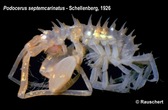
37
Scientific name
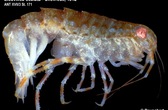
38
Scientific name

39
Scientific name
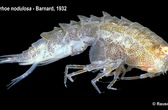
40
Scientific name
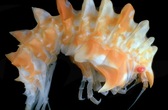
41
Scientific name
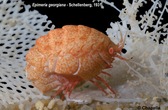
42
Scientific name

Colossendeis specimens are beautiful creatures highly admired in collections due to their larger size compared to other pycnogonid species. The bizarre morphology of pycnogonids is in full display in this genus in which most of the species have a proboscis longer than the trunk. Colossendeis australis is known as a circumpolar and eurybathic (15-3935 m) species and can be recognized by a unique combination of characters that include a downcurved swollen proboscis, subchelate oviger strigilis and short propodal claws. The biology of Colossendeidae in general is poorly known, there is no information about their reproductive biology as no eggs or larvae have ever been found. On the other hand this lineage of pycnogonids could be one of the most ancient according to the phylogeny proposed (Arango pers. comm.).
Although Colossendeis has representatives in all oceans around the world, the deep waters of the Southern Ocean appear as a centre of species radiation for these fascinating animals (Arango pers. comm.).
C. australis is present in a wide bathymetric range from 143 to 3931 m depth (Cano & López-González, 2007). It has a circumpolar distribution and some sites in the Southern Atlantic and Southern Pacific basins, and is found in the Falkland Islands, South Sandwich Islands, Orcadas Islands, South Giorgia, Kerguelen Islands, Antarctic Peninsula, Ross Sea, Adelie Coast and off the coast of Chile and Argentina (Child, 1995).
43
Scientific name

44
Scientific name
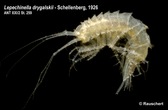
45
Scientific name
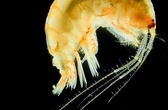
46
Scientific name
British Antarctic Survey
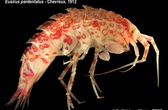
A large amphipod, up to 8cm long.
20 to 2,000m, found on the seafloor or on other benthic invertebrates from Sub-Antarctica to the Antarctic Peninsula and Continent
47
Eusirus perdentatus is a carnivorous predator with occasional scavenging behaviour. It mainly eats other small crustaceans and its diet also includes polychaete worms. It is preyed on by Trematomus fish.
Studies suggest that this animal only breeds once in its lifetime, and the juveniles hatch out at the end of the austral summer.
48
Scientific name
Large and yellow or orange with red eyes and hairs on its antennae. Reaches up to 5.5 cm in length
Oediceroides emarginatus generally lives with its back legs burrowed into sand and head out in the open. It is found from Sub-Antarctica to the Antarctic Peninsula
49
Little is know about its feeding habits but it is probably an opportunistic predator and scavenger
50
Scientific name
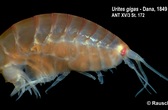
51
Scientific name
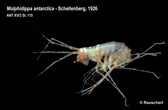
52
Scientific name

53
Scientific name

54
Scientific name
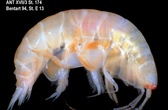
55
Scientific name
British Antarctic Survey
Pale and translucent, with long feather-like hairs or spines on its forelimbs. Grows up to 1cm long.
0 to 250m from Sub-Antarctica and South Georgia to the Antarctic Peninsula and Continent
56
Haplocheira plumosa is a filter feeder, using the feathery net of hairs on its forelimbs to sift food from the water column.*
Antarctic amphipods are generally preyed on by fish and squid.
57
Scientific name
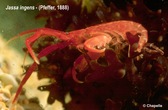
58
Scientific name
